Winter always gets me dreaming of warm destinations and getaways to tropical islands. Walking on a sandy beach surrounded by turquoise waters is the perfect way to escape cold winters. This time around, I decided to explore St. John, one of the United States Virgin Islands (USVI) in the Caribbean. It was the perfect way to start a new year. Let me tell you, in this this guide to St. John, USVI, what you need to know to plan your own trip to this tropical paradise and why it’s worth visiting.
St. John is a Caribbean island. More specifically, it is one of the three U.S. Virgin Islands east of Puerto Rico. The other two islands are St. Thomas and St Croix. St. John is the smallest of the three, but it is the most pristine and full of natural beauty. The island is divided into Cruz Bay overlooking St. Thomas to the west and Coral Bay overlooking the British Virgin Islands to the east. In the middle is the Virgin Islands National Park, which covers most of the island.
Table of Contents
What to do at St. John, USVI
Check out amazing beaches and get out on the water
As an island, St. John, USVI, has numerous beaches. Most beaches are on the northwest and north side of the island, close to Cruz Bay. However, you will find a few beaches on the south side as well. If you like water activities, you will find stand-up paddle board, kayak, and boat rentals. Dive into the turquoise waters in search of the coral reefs surrounding the island.
Here are a few beaches to get you started.
Trunk Bay
Trunk Bay is by far the most popular beach on the island. It is perfect for beach walks, kayaking, or snorkeling. In fact, you will find a snorkeling trail here that spans 650 feet. The trail is covered in underwater educational signs that explain the local coral formations and fish. You can rent snorkel gear right on the beach. Trunk Bay is part of Virgin Islands National Park and has a lifeguard on duty. The beach also has restrooms and showers.
Note that Trunk Bay is the only beach on the island with an entry fee.
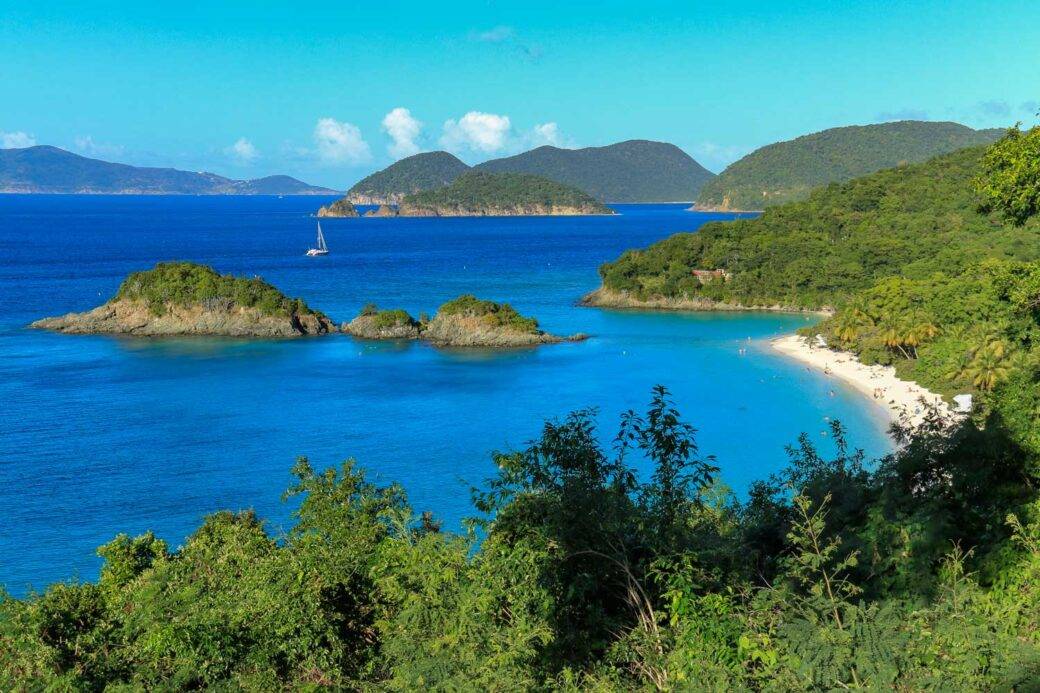
Pro Tip. Trunk Bay is the busiest beach on the island, and it is difficult to find parking. Unless you’re staying at a hotel or resort that provides shuttle service to the beach, make sure you get there early to secure a parking spot.
Salomon Bay
Salomon Bay is the closest beach to Cruz Bay. However, this beach is only accessible by a hike, making it one of the most secluded beaches on the island. To get to Salomon Bay, you need to hike a 2.3-mile loop via Lind Point trail. Alternatively, you can get here faster from Honeymoon Beach.
Honeymoon Beach
Honeymoon Beach is another popular beach due its easy access from Cruz Bay. In fact, it the closest beach to Cruz Bay that does not require a hike. Other advantages include the availability of beach rentals, restrooms, and refreshments.
Maho Bay
Maho Bay is more protected than other beaches and has shallow waters, making it perfect for kayaking and stand-up paddle boarding. You will find stand-up paddle board and kayak rentals across the street from the beach. Maho Bay is known for the sea turtles that frequent it.
Note that this beach gets crowded easily. If you want a shaded spot, it is best to arrive early, since there is not a lot of shade available.
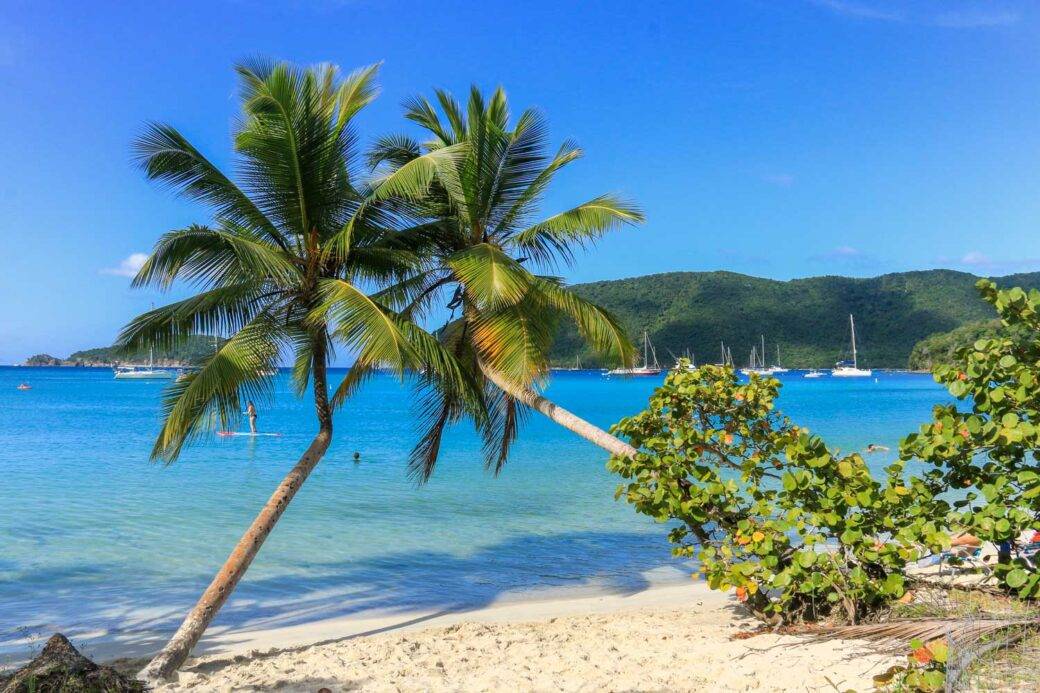
Salt Pond Bay
If you really want to avoid crowds, choose Salt Pond Bay. This beach is south of Coral Bay and is very secluded. In fact, it is the southernmost beach on the island, accessible by a 10-minute walk downhill from the parking lot.
Hawksnest Bay
Hawksnest Bay is one of the smaller but easily accessible beaches near Cruz Bay. If you’re looking to get away from crowds on Trunk or Maho Bay, you can enjoy a peaceful stroll here.
Cinnamon Bay
Along with Trunk Bay, Cinnamon Bay is one of the longest beaches. It is perfect for beach walking, spotting fancy mansions on Peter Bay and nearby islands in the distance. Cinnamon Bay is a wide beach, making it another great spot for stand-up paddle boards and kayaks while connecting to nearby Maho and Francis Bay. Unfortunately, there are currently no rentals available here.
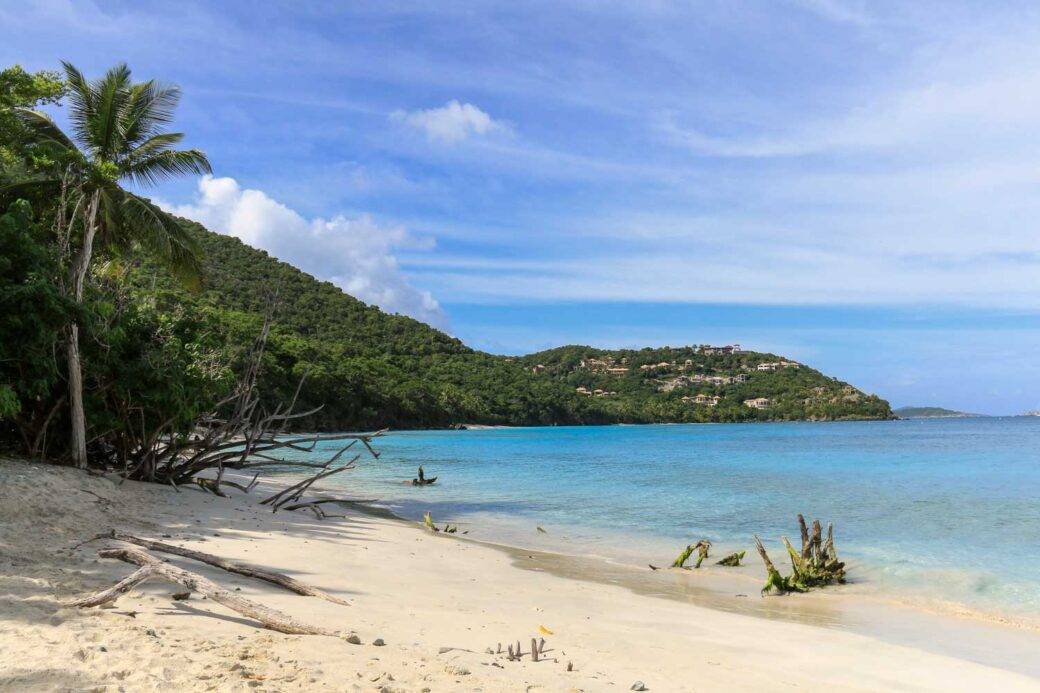
Explore historic ruins of sugar plantations
Get to know a bit of the history of St. John, USVI. Columbus discovered St. John in 15th century but it was Denmark that formally established their settlement there in 17th century. The Danes brought slaves captured in West Africa and planted sugar and cotton all over the island. Today, you can find numerous sugar plantations ruins scattered across the island reminding us about the island’s dark history. Here are a couple noteworthy ones worth visiting that are also easily accessible.
Visit the Peace Hill Windmill
This windmill was used for sugar production at Denis Bay Plantation in the 18th century. You will find impressive views from the hill overlooking Hawk Nest Bay and Denis Bay toward Trunk Bay. It is also a great spot to catch a sunset. The Peace Hill sugar plantation windmill is a short drive from Cruz Bay and an even shorter hike from the parking lot. If you’re interested in making a trip to the beach, there is a trail that leads from Peace Hill. You will find this beach more private since it is only easily accessible by hike.
Make a stop at Annaberg Plantation
Annaberg Plantation, dating to the 18th century, has the best-preserved sugar plantation ruins and is easily accessible by car. If you are interested in sightseeing remains of sugar plantations, I recommend making a stop there. Annaberg used to be one of the biggest sugar producers. The ruins include the windmill tower, factory, and slave quarters. You will find informational signs to guide you and help you learn more about the place. The site is on the north side of the island and offers a nice view of Leinster Bay.
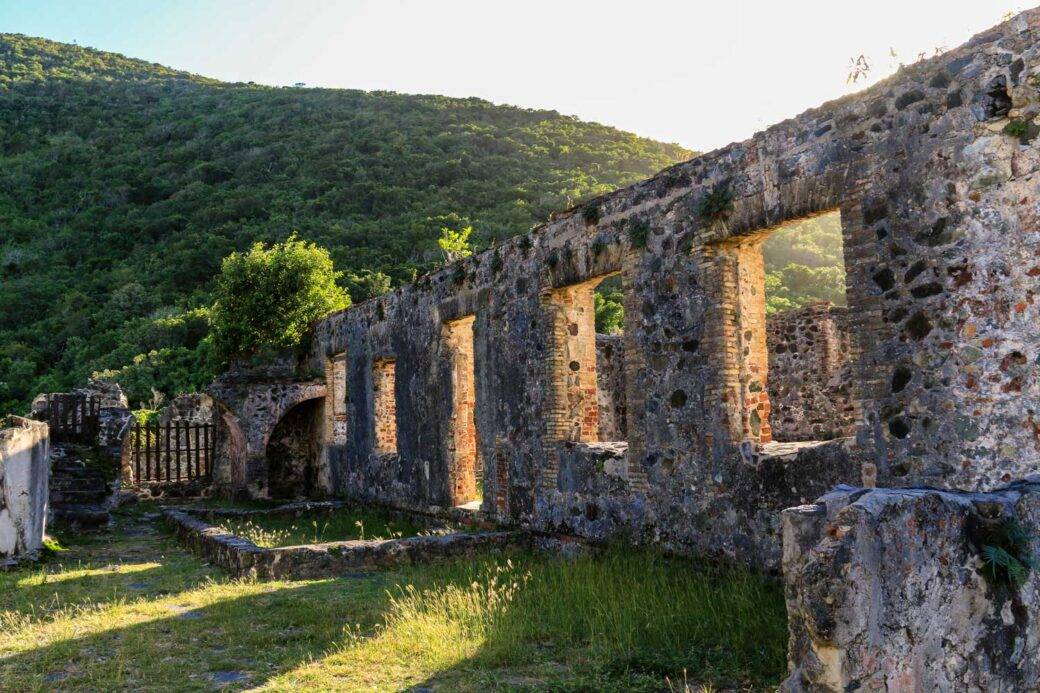
Hike in the Virgin Islands National Park
Most of St. John, USVI, is a national park with 20 trails to choose from. Whether you are looking for beach views, a stroll in shaded woods, or historical ruins, you will find it there. Here are two of the historical trails worth checking out.
Examine pre-Columbian petroglyphs by following Petroglyph Trail
In the Virgin Island National Park, you can see pre-Columbian petroglyphs. If you’re planning to take the Reef Bay hike, you will find ancient petroglyphs in the Reef Bay Valley. Just follow the signs for Petroglyph Trail. The trail itself is 3.3 miles long both ways and rated as easy. Petroglyphs are thousands years old and used by the native people that inhabited the island before European settlers conquered St. John. These rock cravings situated beside a quiet pool remain a mystery to this day, but they most likely served a religious purpose.
Take a Reef Bay hike to Reef Bay Sugar Factory
One of the fun trails to hike is Reef Bay Hike. It is a 4.4-mile-long, out-and-back trail rated as moderate. It takes you through a shady forest with the visible remains of sugar mills along the way. The trail leads to the ruins of Reef Bay Sugar Factory towards the end of the trail and ends at the beach. The factory dates back to the 19th century and is well preserved. Interestingly, it was functional until the mid-20th century.

Go shopping at Mongoose Junction
If you need to shop for beach gear or look for souvenirs, visit Mongoose Junction on Cruz Bay. You will find beach clothing and accessories, local artwork, and jewelry. For those of you looking for gift ideas, check out larimar – the “gemstone of the Caribbean.” Larimar is a blue variety of pectolite. It is only found in an extinct volcano in the Dominican Republic. Once you’re done shopping, enjoy delicious food and craft cocktails.
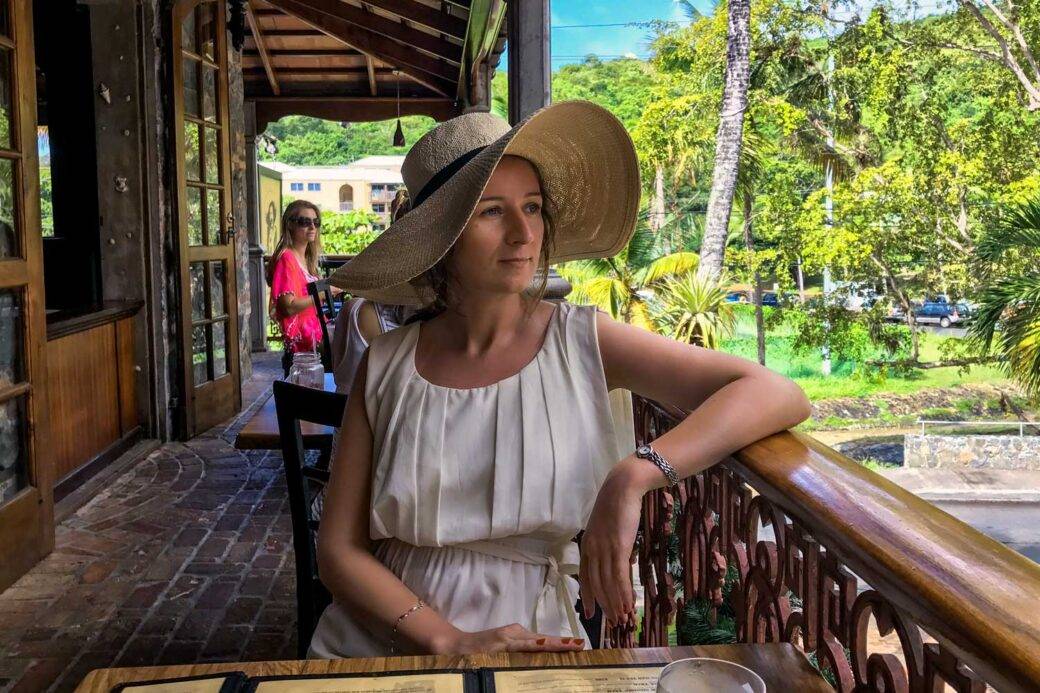
Logistics guide to planning your trip to St. John, USVI
How to get to St. John, USVI
There is no airport on St. John. To get to St. John, USVI, you need to fly to St. Thomas. Since it is a small airport, you will likely need a connecting flight. Coming from the continental U.S., my connecting airport was Atlanta. Once you get to St. Thomas, cross the island to the Red Hook Ferry Terminal, where you can catch a ferry to St. John.
There are both people and car ferries here. Car ferries run less frequently, so make sure you consult the schedule and arrive ahead of departure time if you’re renting a car at the airport. It takes about half an hour to get to St. John Cruz Bay.
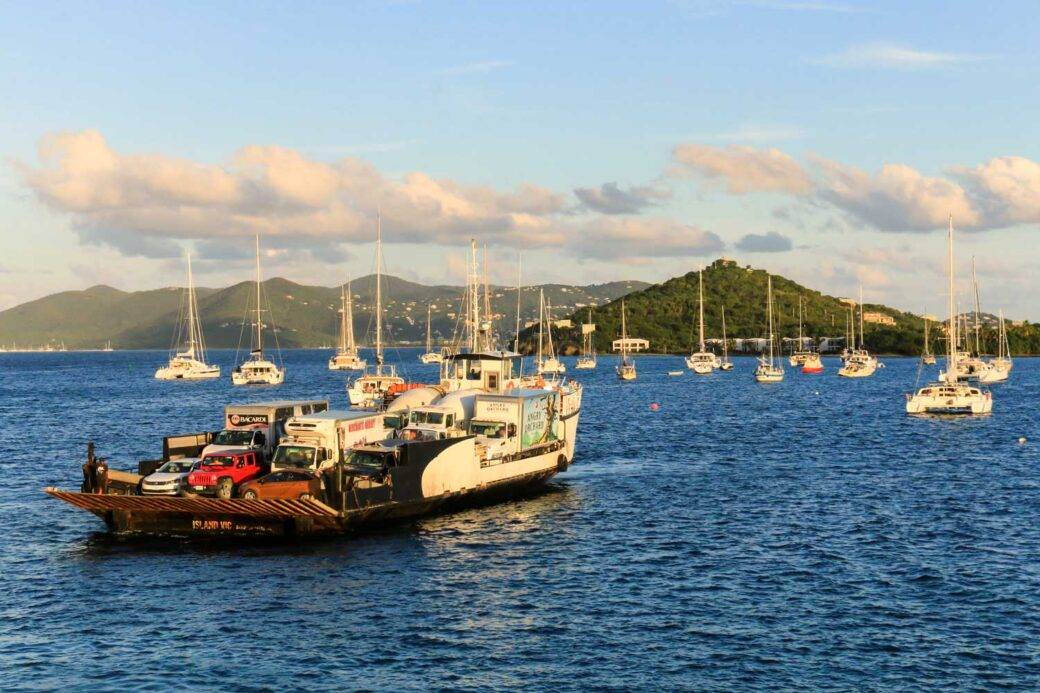
Best time to visit St. John, USVI
Winter in the northern hemisphere is the best time to plan your trip to St. John, USVI. The climate in the Virgin Islands is tropical, which means it is hot all year.
Winter months tend to be a little bit cooler and drier. Even though December to April is the busiest time to visit, warm temperatures and low rainfall make it a perfect time to escape winter in the continental U.S.
If you’d rather visit during more peaceful months, consider May to July. However, the weather is hot and muggy that time of year.
Be aware that hurricane season starts in August and lasts until November. You are also more likely to get rainfall during that time. The last strong hurricanes to hit St. John were Irma and Maria. They hit the islands in September of 2017, both as category 5 storms, and caused a lot of damage.

Where to stay at St. John, USVI
If you’re wondering where to stay on the island, you have the option of either Cruz Bay or Coral Bay. Cruz Bay is more popular and offers more accommodation options, including resorts and hotels. Coral Bay is smaller, more secluded, and only offers vacation rentals.
I found a cute treehouse on VRBO and decided I needed to stay there before planning any other aspect of my trip. It is very popular, therefore I had to reserve months in advance (I reserved it in spring for January of the following year), but it was well worth it. I arrived at night, but when I woke up the next day, I witnessed some marvelous views of Coral Bay. My neighbors, numerous lizards and crabs, kept me company while having breakfast. I very much enjoyed staying at the treehouse. It was secluded, had beautiful views, a jacuzzi, a grill, a hammock, and an outdoor kitchen where I could make meals. The only downside was that there were a lot of mosquitos, and the drive uphill was very steep. I’m glad I rented a jeep.
How to navigate St. John, USVI
If you’re planning to explore the island, I recommend renting a car. You can either rent one on St. Thomas and ferry to St. John or get to the ferry, cross to St. John, and then rent a car there. I found it more convenient to rent a car right away. The only advantage of waiting to rent a car on St. John is a shorter wait to get a ferry, since people ferries runs more frequently than car ferries.
St. John is rather hilly, so depending on the location of your rental, you might need a jeep. A jeep is the preferred car to navigate St. John. If you plan to relax and stay at the resort, you will not need a car, as resorts offer transportation to the beaches. You can also opt for a taxi if needed. Note that there are no ride sharing companies on the island such as Uber or Lyft.
A few notes about driving on St. John, USVI:
- On St. John, you drive on the left side of the street. However, the steering wheel is located on the left side as well. You’re basically driving a standard American car on the left side of the road.
- Drinking and driving is permittable on St. John, USVI, so be careful as you hit the road.
- Watch out for donkeys as you drive. Also, please do not feed the donkeys. This makes them more likely to get on the road looking for human food, creating a safety hazard.

Pro tip. If you’re planning to cook your own meals, you might want to get groceries on St. Thomas before you get on the ferry. I was initially told that food was more expensive on St. John, so I shopped at St. Thomas. As a larger island, St. Thomas offers more choices, but I did not find food to be that much more expensive on St. John. However, St. John did have limited selection.
For those of you traveling on a budget, St. John offers public transit system called VITRAN. However, public buses do not cover the whole island. Nonetheless, buses travel to tourist areas an even some residential areas. Discounts are available for seniors and students.
What foods to try at St. John, USVI
USVI cuisine consists of a mix of indigenous and imported ingredients brought by the various cultures that inhabited the island over the centuries. The island offers many restaurants and bars on Cruz and Coral Bay that serve Caribbean cuisine including anything from seafood to BBQ and jerk dishes.
The local alcohol is rum. My favorite alcoholic drink was the Painkiller. This classic Virgin Islands drink contains rum, pineapple juice, coconut, orange juice, and a pinch of nutmeg. You can also get coconuts with rum that are yummy and very common.
As you eat out, you will notice a large population of wild chickens. They were initially brought to Virgin Islands from Cuba and other Caribbean Islands for food and cockfighting. Chicken were released when cockfighting became illegal and they now roam free.
Traditional dishes to sample on your next St. John, USVI, trip:
- Start with the island’s national dish, fish & fungi. Fungi is a dumpling made from salted cornmeal, okra, water, and shortening. It is typically served with fish or meat.
- If you want to feel like a local, taste rice & beans with added herbs and spices.
- For soup lovers, I recommend kallaloo. It is a stew made from the leaves of the dasheen plant with the addition of okra, fish, meats, onions, hot peppers, and spices.
- Consider the island’s favorite conch fritters,which are battered and friend conch balls. This finger food is typically served with sweet and spicy sauce. Conch can also be served in chowder.
- If you like spicy BBQ flavor, try jerk chicken, meats, and fish. The jerk style of cooking involves coating a main ingredient in spices and then slow cooking it.
- For a light snack, consider pates or roti. Pates are deep fried pastries with meats, fish, and/or vegetable filling. Roti is fluffy dough wrapped around spiced or curried meat and vegetables.
- Finally, try johnny cake, which is deep friend biscuit or cake that can be eaten hot or cold.
Overall
My stay at St. John, USVI, was very relaxing. I found an island to be a great place to recharge my batteries. I loved learning about St. John’s culture and history, discovering the natural beauty of Virgin Island National Park, and visiting beaches.
I enjoyed relaxing on the beach with the wind in my hair, a Painkiller in my hand, and engaging in casual conversations with locals. During these interactions, I learned that there were not many individuals who were native to the island. Most people seemed to be from the continental U.S. who came to visit St. John and decided to stay a bit longer. It does not surprise me at all. St. John, USVI, is a perfect tropical getaway with a slow pace of life, beautiful landscapes, delicious Caribbean cuisine, and friendly residents. I didn’t explore any neighboring islands this time around, but there is always next time.
I hope that this guide to St. John, USVI, inspired you to plan your visit to this tropical paradise. Any questions? Please leave them in the comments. Happy planning!








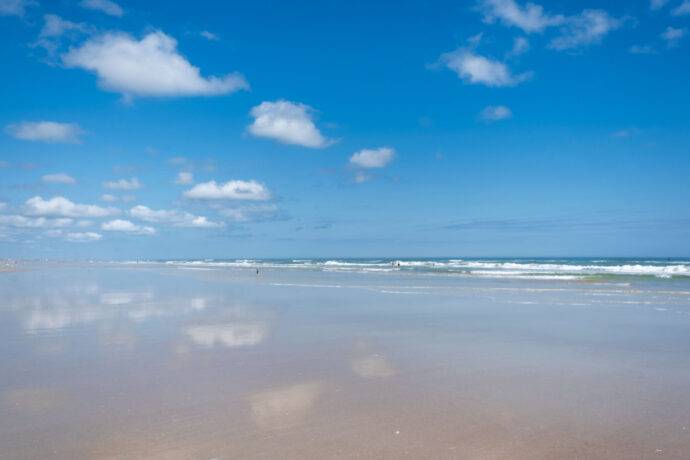


No comments